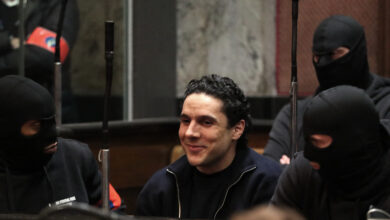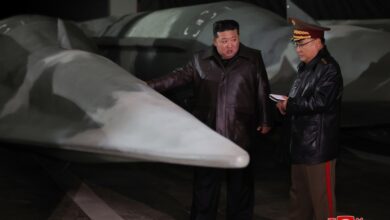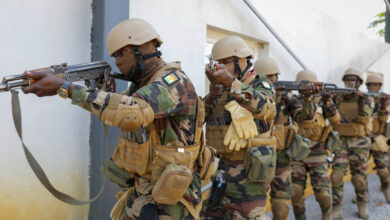
The Iraqi Security Forces and federal police currently fighting the last pockets of ISIS are not the same men who famously cut and ran when the militants first overran their cities more than three years ago. Battle-hardened and trained by the 73-member U.S.-led Coalition, these troops are not only confident and decisive, but preparing for a future where what’s left of ISIS is relegated to a terrorist insurgency.
Last week the ISF launched the operation to retake Qaim and Rawa, Islamic State’s last urban strongholds in the country’s western Anbar province near the border with Syria. Earlier in the month they recaptured Hawija, just two weeks after beginning the offensive.
In an hour-long interview with The Defense Post, Coalition spokesperson Colonel Ryan Dillon talked about how the Iraqi troops have changed, the battle for Mosul and continued insurgency threat, and how the Coalition assesses civilian casualty reports.
The battle for Mosul
A United Nations report released Thursday said ISIS members should face international charges for “serious and systematic violations” against civilians during the Mosul campaign. The militants intentionally shelled civilian residences, targeted people trying to flee the city and used them as human shields against the approaching Iraqi forces.
“We’re talking about nine grueling months of a fight between the Iraqi Security Forces and the determined, deadly ISIS that had two-and-a-half years of occupation to build up their elaborate defenses. And a lot of that had included putting up obstacles throughout the entire city. They riddled [Mosul] with improvised explosive devices – essentially mines or booby-traps set throughout the city – of every size and description,” Dillon said.
U.S. officials have called the Mosul operation one of the most complex urban battles since World War II. Prior to the launch of the offensive in October 2016, the Coalition estimated there were between 3,000 and 5,000 ISIS fighters remaining in the city.
“You have multi-level buildings, you have subterranean tunnel systems, and then they had mutually-supporting fortified positions. They knew the main avenues of approaches as the Iraqi Security Forces would come into the city and would establish choke points and fortified fighting positions to catch the Iraqi Security Forces as they would attempt to liberate the city,” Dillon said.
ISIS fighters also tried to develop chemical weapons, and used – to great effect, according to press reports – suicide vehicle borne improvised explosive devices, or car bombs. Dillon said the SVBIEDs took the form of armored cars, which the militants would fill with explosives and attempt to drive straight into the ISF front lines.
http://gty.im/866232140
Dillon explained that some 10 to 15 percent of the fighters who make up the ISIS ranks were foreign fighters, “who came here to fight and came here for the caliphate, and will fight to the end.” Another 10 to 15 percent were the hardcore fighters. In all, about 30 percent of them were ready to die, especially in Mosul, which was once their largest city and accounted for a majority of their resources, including financial.
By the time the battle wound down in West Mosul, many of the ISIS militants were dead, and some tried to sneak off among the city’s refugees, but the remaining 100 or so chose a more gruesome fate.
“As the ISF finished up the last remaining square kilometers or square meters of Mosul, the Iraqi Security Forces had bulldozers that were literally pushing through the last patches of rubble, and they were churning up rubble, and there were ISIS fighters that were being buried in this rubble, still fighting, with Iraqi Security Forces on the flanks of these bulldozers, throwing grenades and shooting the final ISIS fighters. We’re talking combat that you would typically only think about seeing in the movies, but it was a reality in Mosul.”
In the end, somewhere around 1,500 Iraqi troops were killed in the operation, and another 8,000 were wounded. “There is no question that they paid a very dear price for that hard-earned victory,” Dillon said.
But the ISF prevailed, and have gone on to defeat ISIS in Tal Afar and Hawija, and are now fighting in Qaim and Rawa.
“Some of them have seen what it was like to live under ISIS control, and they never, ever want to go to back to living something like that,” Dillon said of the ISF.
http://gty.im/862764180
The events of 2014, when the Iraqi forces ran from the fight as soon as ISIS showed up, are a source of embarrassment to some. “But they have seen what it was like, and maybe they’re also fighting to kind of make up for that as well,” Dillon said. He noted that training from the U.S. and other Coalition members has helped, along with airstrikes and other assistance, but the Iraqis have proven to be successful in their own right.
Frankly, they are also more confident now.
“I think you see it when you go and meet some of these Iraqi guys who have been through the fight, and they walk around confidently knowing that they have been through likely the worst, which is Mosul, and they’ve come out of it. They don’t want to go back to do something like that ever again.”
While it is still unsafe for many people to return to some areas, including Raqqa where IEDs planted by ISIS have killed even the head of the Raqqa police, Idris Mohammed, civilians are slowly beginning to return to Mosul.
The Coalition says 225,000 people returned to their homes in Mosul as of October 7. Prior to ISIS taking over the city, Mosul’s population was estimated upwards of 2.5 million, but fewer than 700,000 remained after two years of occupation. The U.N. estimates that more than 2,500 civilians were killed in the nine-month battle, mostly at the hands of ISIS.
Many thousands of people remain displaced throughout all of Iraq and Syria. The U.N. Refugee Agency launched its winter assistance program for refugees in Iraq and Syria this week, and will provide over 100,000 families with aid during the coldest months of the year.
Counting civilian casualties
The use of airstrikes in both Syria and Iraq, especially during the Mosul campaign, has led to questions over the Coalition’s role in causing civilian casualties. The monitoring group Airwars has estimated that 1,200 civilians were killed in Coalition actions in Mosul.
According to its last monthly report released on October 27, the Coalition has carried out 27,566 strikes since September 2014, and 1,266 civilian casualties have been reported. The Coalition assesses that 194 of those reports are credible.
The team responsible for investigating civilian casualty reports now has seven members, and Dillon said they are chosen for their backgrounds – members have included Army, Navy and Marine Corps personnel, civil affairs advisors, pilots, imagery specialists, and lawyers.
http://gty.im/811187552
The Coalition will also bring in specialists for certain assessments, such as one where the team investigated an allegation that 10 people were killed in a strike on a would-be car bomber who was driving toward friendly forces. There were no photographs, and the team could not see any dead bodies in the videos.
“We struck the vehicle. The vehicle with all the explosives it had, it blew up,” Dillon said. “It didn’t level any of the buildings around it; however, we reached outside of the civilian casualty assessment team to get blast experts to then look at and say, ‘Alright, here’s a blast that happened. If someone were in this building, could they have been killed?’”
At the time of the interview, the assessment was not finished, but Dillon said the casualty claim would be considered credible even though the car bomb was a legitimate military target.
“If we determined that there were civilians that were in that structure and we determined that they could have been killed as a result of that blast, then that could be considered credible and we would have had to take responsibility for it.”
The team considers each report on a case-by-case basis, and will reopen investigations when more information is available, Dillon said. Recently, the Coalition acknowledged that four civilians were unintentionally killed in an April 2015 strike near Mosul. The team had closed the case but reopened it after the family provided more details.
“We will go through and we will do a full detailed assessment, talk to pilots, go back and look at all of the different types of information, going back days before, looking at full-motion video to show the patterns of life leading up to particular strikes and then afterwards, so there’s a lot of effort that goes into these,” Dillon said.
Dillon said he recently spent about two hours with the assessment team, during which they “may have gotten through one or two cases.”
“These were almost immediately not credible, but still the time and the effort that goes into looking at each allegation … I was impressed in the amount of detail and the amount of time it takes to go through each one. I know that we have gotten some criticism with all of the allegations that remain open, but it really goes to show that these are not finger drills.”
Continued threats and counterterrorism operations
The Iraqi forces now seem to be on the brink of what seemed impossible just a few years ago: Ousting ISIS from nearly all of its self-proclaimed caliphate. The country is intact, and the militants have not retaken any territory.
ISIS in the future will probably look more like an insurgent group than an army, but U.S. and Iraqi officials know that ISIS will not disappear just because they’re defeated militarily.
Dillon said the Coalition is currently training the Iraqi Security Forces to deal with the terror group in the future through policing and intelligence to identify threats before they can turn into attacks.
http://gty.im/811421446
One initiative the Coalition has rolled out is the “police presence in a box,” a self-contained police station that can easily be distributed to the Iraqi Federal Police across the country.
Canadian Brigadier General D.J. Anderson announced the project in June, saying the “boxes” are intended to help the Iraqis reestablish local police stations and equipment in areas where ISIS destroyed their infrastructure. Housed in shipping containers, the makeshift police stations include furniture, a tent, lighting, water supplies, and two vehicles.
So far 10 have been distributed to the Interior Ministry, Anbar and Ninewa police, and to Camp Dublin for training purposes. Similar kits are intended for the police who patrol the border with Syria.
Still, the Iraqis have to learn to identify potential attacks before they happen, as was the case last month in Ramadi, when ISIS fighters attacked ISF positions, killing seven soldiers and injuring 16 others over the course of several hours. ISIS had not held Ramadi since late 2015.
One of the tactics ISIS used in Mosul and other parts of Iraq and Syria was weaponizing hobbyist drones to drop mortars on unsuspecting troops. The Coalition went after not only the fighters but their factories and the people manufacturing the weapons, hitting them with airstrikes before the drones could ever be launched.
The Coalition was largely able to dismantle the whole threat of drones, Dillon said, reducing their use from about six sightings per month in Syria and Iraq down to about two over the last few months.
On October 31, the Coalition said in an emailed statement that its airstrikes had killed multiple ISIS leaders involved in drone operations in Iraq and Syria, listing 11 men who were responsible for drone and other military procurement, research and development.
http://gty.im/800164224
Dillon noted that after the Ramadi incident, Operation Inherent Resolve commander Lieutenant General Paul E. Funk and Coalition officials met with the U.S. Ambassador to Iraq, Douglas Silliman. The ISF and Anbar police were able to put down the attacks quickly, and people at the meeting “opined that, had this been three years ago, it would have been a completely different turnout and a different story,” Dillon said.
“You have to learn from every chance that you can, and I think that they’re definitely capable and they recognize the same thing, and will have to do what they need to to transition for that, and we’re going to be there to help them out.”










